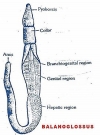BALANOGLOSSUS: AFFINITIES AND PHYLOGENETIC RELATIONS
Monday, 05 June 2017 17:46Hemichordates show non-chordate and chordate features. These animals show more non-chordate hence Hyman objected its inclusion in the phylum chordata. Bateson included it in the phylum chordata.
- Gegenbaen kept Balanoglossus in Enteropneusta group.
- Sedgewick and Huxley described its chordate nature.
- 1887 Bateson kept this in pnyl um chordate.
I. Affinities with Annelida: Spengel stated that Balanoglossus resembles annelids more,
(a) Resemblences:
- Presence of worm like-body.
- Presence of burrowing or tubicolous habit.
- Presence of dorsal heart.
- Presence of similar blood vascular system in both groups.
- Presence of ventral nerve cord.
- Tornaria resembles trochophore larva of annelids.
(b) Differences:
- Presence of dorsal tubular nerve cord.
- Presence of gills in the pharynx.
- Absence of Nephridia in tornaria larva.
- Presence of stomochord.
- Development differs from anneliden development.
II. Affinities with Echinodermata:
(a) Resemblences:
- Presence of enterocoelic coelome.
- Presence of heart in Balanoglossus is homologus to dorsal sinus of echinoderms. "S”
- Presence of poorly developed nervous system.
- Presence of creatin a muscular phosphogen.
- Tornaria resembles Bipinnaria of echinoderm.
Serological tests and biochemical tests proved that both groups are closely related.
(b) Differences:
- Bipinnaria will not show apical tuft of cilia which is seen in tornaria.
- Echinoderms show radial symmetry whereas Balanoglossus will show bilateral symmetry.
- Echinoderms will show water vascular system where as it is absent in Balanoglossus.
III. Affinities with Nemertines:
(a) Resemblences:
- Presence of worm like appearance.
- Presence of ciliary mode of feeding.
- Presence of burrowing life.
- Presence of segmental arrangement of gonads.
(b) Differences:
- Balanoglossus contains dorsal tubular nerve corel, it is absent in hemertines.
- Lateral nerves are present in hemertines they are absent in Balanoglossus
IV. Affinities with Chordates:
a) Resemblences:
- Presence of notochord.
- Presence of dorsal tubular nerve cord.
- Presence of pharyngeal gills.
- The structure of pharynx resemble in both groups.
- Presence of entero coelic coelom.
b) Differences:
- The stomochord of Balanoglossus should not be compared with the notochord. Stomochord is present only in the proboscis. It is not covered by sheaths. It is hoilow. It will not give strength hence it should not be called notochord.
- Balanoglossus will show ventral nerve cord.
- Balanoglossus dorsal nerve cord is hollow in the collar region only.
- In Balanoglossus the gills are present towards dorsal side, but in chordales they are lateral in pwsitia. Thus Balanoglossus differs from chordata.
Conclusion:
- Most probably Hemichordates and chordates might have evolved from the same ancestor.
- Newman kept thisgroup in between echinodermate and chordate.
- Hyman considered them as invertebrates.
We can consider this as primitive chordate group.
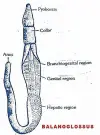
GENERAL CHARACTERS AND CLASSIFICATION OF HEMICHORDATES
Monday, 05 June 2017 17:26
REPRODUCTIVE SYSTEM, AND EMBRYO DEVELOPMENT IN BALANOGLOSSUS
Monday, 05 June 2017 17:04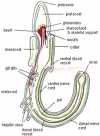
BLOOD VASCULAR SYSTEM IN BALANOGLOSSUS
Monday, 05 June 2017 16:34
RESPIRATION MECHANISM IN BALANOGLOSSUS
Monday, 05 June 2017 16:23
DIGESTIVE SYSTEM OF BALANOGLOSSUS
Monday, 05 June 2017 16:09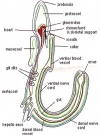
ANATOMY OF BALANOGLOSSUS
Monday, 05 June 2017 15:51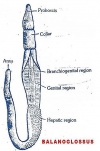
BALANOGLOSSUS: HABIT, HABITAT AND EXTERNAL CHARACTERS
Monday, 05 June 2017 15:35
WATER VASCULAR SYSTEM IN DIFFERENT ECHINODERMS
Monday, 05 June 2017 14:40
ECHINODERMATA GENERAL CHARACTERS AND CLASSIFICATION
Monday, 05 June 2017 14:13
FORMS OF ECHINODERMATA LARVA
Monday, 05 June 2017 13:33
FERTILIZATION AND DEVELOPMENT IN STAR FISH
Monday, 05 June 2017 12:18
NERVOUS SYSTEM AND SENSE ORGANS OF STAR FISH
Monday, 05 June 2017 11:41
BLOOD VASCULAR SYSTEM IN STAR FISH
Monday, 05 June 2017 11:25
WATER VASCULAR SYSTEM IN STARFISH
Monday, 05 June 2017 11:09
DIGESTIVE SYSTEM AND THE PROCESS OF DIGESTION IN STAR FISH
Monday, 05 June 2017 10:54
